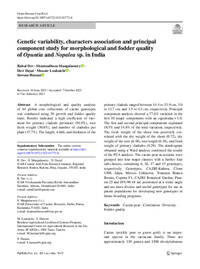Genetic variability, characters association and principal component study for morphological and fodder quality of Opuntia and Nopalea sp. in India

Authors:
A morphological and quality analysis of 64 global core collections of cactus genotypes was conducted using 30 growth and fodder quality traits. Results indicated a high coefficient of variation for primary cladode perimeter (91.0%), root fresh weight (50.8%), and number of cladodes per plant (47.7%). The length, width, and thickness of the primary cladode ranged between 14.4 to 53.9 cm, 5.0 to 13.7 cm, and 1.5 to 4.3 cm, respectively. Principal component analysis showed a 77.6% variation in the first 10 major components with an eigenvalue > 1.0. The first and second principal components explained 18.5% and 14.8% of the total variation, respectively. The fresh weight of the shoot was positively correlated with the dry weight of the shoot (0.72), dry weight of the root (0.48), root length (0.38), and fresh weight of primary cladodes (0.29). The dendrogram obtained using a Ward analysis confirmed the results of the PCA analysis. The cactus pear accessions were grouped into four major clusters with a further four sub-clusters, containing 6, 26, 17 and 15 genotypes, respectively. Genotypes, CAZRI-Kukma, Clone 1308, Jalpa, Mexico Unknown, Trunzara Bianca Bronte, Copena F1, CAZRI Botanical Garden, Piantra- 25 and IPA-90-18 are positioned at a wider angle and are more diverse and useful genotypes for use as parent populations for developing new genotypes in future breeding programs.
